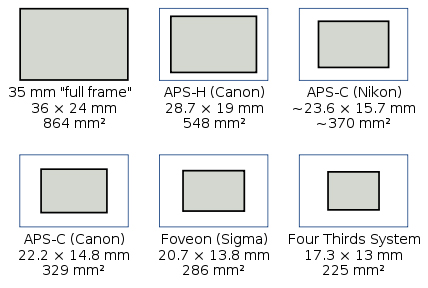
If you placed your camera and 16mm fisheye lens in a small square room, standing close to one wall, in the center of that wall, your camera would see the wall across from you as well as the walls to your left and to your right.
FULL FRAME SENSOR SIZE VERSUS FOUR THIRDS FULL
For example an ultra wide-angle lens like a 16mm fisheye lens (made to cover Full Frame sensors) will have a 180° horizontal field of view. FIELD OF VIEWįield of view or more accurately stated, “horizontal angle of view” is a measurement in degrees along the horizontal axis to determine just how much of the world you will see when looking through a lens. The Canon 5D Mark IV is 30.4 megapixels, which is about 30,400,000 pixels, which is 6720 x 4480 pixels, and in theory could also be called 6.7K. I say “roughly” since a common “4K” resolution is actually 3840 x 2160 pixels, and there are multiple pixel counts that are accepted as “4K.” In still photography digital cameras, pixel count is often measured in “megapixels.” One megapixel = 1 million pixels. For instance 4K represents roughly 4,000 pixels in the horizontal axis of a 4K image sensor. We are now abbreviating these numbers by using “Ks” (2K, 4K, 6K, 8K etc.). For instance 1920 x 1080 is the standard pixel count for HD cameras. This can be measured in horizontal x vertical. For digital sensors, according to international standards, it’s accepted to use the term “Number of Recorded Pixels” or “Number of Effective Pixels.” This is the number of individual pixels on a given sensor that contribute to the final image. RESOLUTION & PIXEL COUNTįor film, resolution is the term used to describe how much detail can be resolved usually measured in line pairs (lines per mm or lines per inch). For the remainder of this article this format will be referred to as “Full Frame.” In the chart below the red rectangles represent the relative physical size of many common cameras and formats.

A Full Frame digital sensor like the ones found in a Canon 5D, Sony a7S I II or the Sony Venice, as well as traditional 35mm still photography film, all have areas that measure roughly 36x24mm. Sensor size is the physical size (area, not number of pixels) of a camera’s image sensor, usually measured in mm width x height. Also, not all lenses work with all formats, and not all formats are the right choice for every project. All these formats need lenses, and the lens market is bigger and more confusing than ever. Today with digital cameras, we have more formats than ever: 1/2”, 2/3″, Micro Four Thirds, Super-35, DX, APS-C, Full Frame, Vista Vision, etc. These are literally measurements of the physical size of film used to capture the images (in this article, I won’t dive into exactly how the film is measured and what direction it passes in front of the camera). Motion picture film formats are fairly straight forward: 8mm, 16mm, 35mm, 70mm.

digital or film? If film, which format? If digital, what camera and sensor size? There is no single “best” format that is right for every project or situation.

However it’s important to know the differences as well as what results should be expected before selecting your sensor size and lenses. With the release of more high-end video cameras with larger sensors like the ARRI Alexa LF, Panavision DXL2, RED MONSTRO, and the Sony Venice and more recently with the Sony FX-9, Canon C500 II, Sony A7S Mk III & Panasonic S1H we have more choices than ever when it comes to formats and lens options. – “What will full frame lenses look like on a S-35 sensor.”Īrticle reproduced with kind permission from the online rental marketplace ShareGrid MORE FORMATS THAN EVER This article aims to help questions such as:


 0 kommentar(er)
0 kommentar(er)
